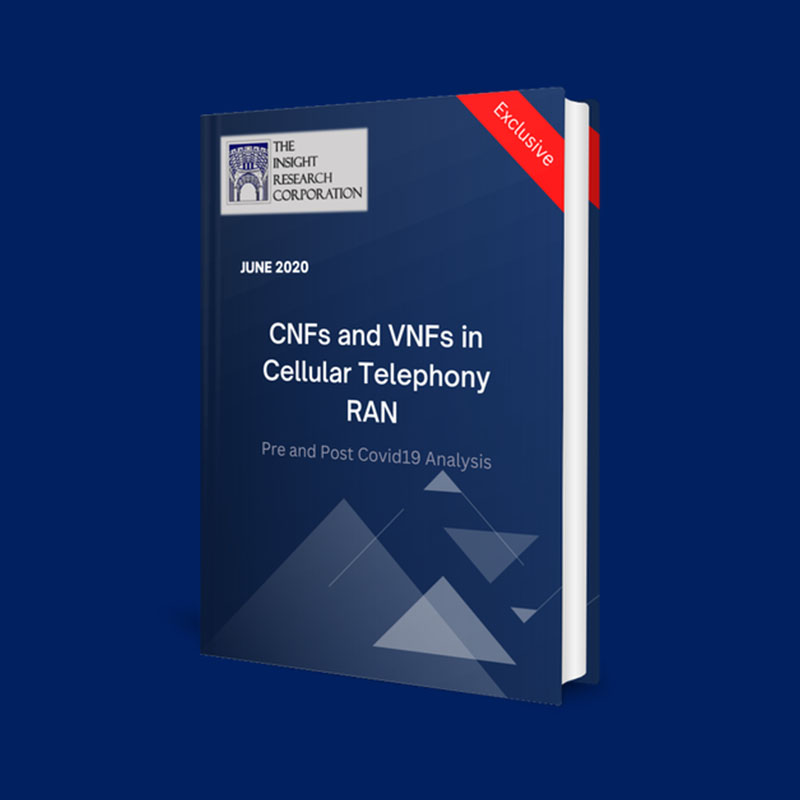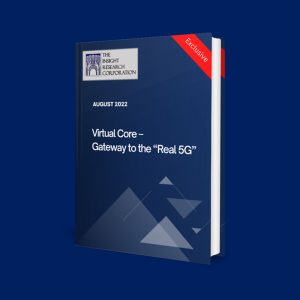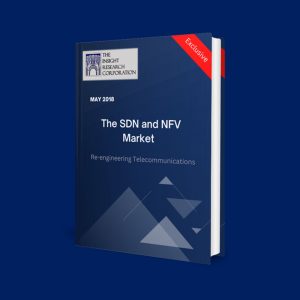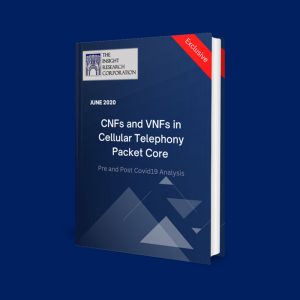Description
CNFs in RAN present the ultimate frontier in network function engineering. Insight Research forecasts a jump of about 9 percent in the share of RAN CNFs. The jump is indicative of the enormous potential that CNFs have for RAN, especially in the DU segment. At the same time, the path towards cloud nativity is paved with real challenges surrounding concerns related to latency and performance management. RAN VNFs or vRANs, on the other hand seem to be headed towards stability as shoots of consensus begin to emerge among the multiple RAN virtualization and cloudification initiatives. In the long run, it is clear that telcos and RAN product engineers need to crack the challenge surrounding expensive but reliable existing fronthaul technologies such as CPRI. This challenge has to be met head on either at the physical level or at the protocol design level or in a combination of the two.
Hightlights
CNFs in RAN present the ultimate frontier in network function engineering. Insight Research forecasts a jump of about 9 percent in the share of RAN CNFs. The jump is indicative of the enormous potential that CNFs have for RAN, especially in the DU segment. At the same time, the path towards cloud nativity is paved with real challenges surrounding concerns related to latency and performance management. RAN VNFs or vRANs, on the other hand seem to be headed towards stability as shoots of consensus begin to emerge among the multiple RAN virtualization and cloudification initiatives. In the long run, it is clear that telcos and RAN product engineers need to crack the challenge surrounding expensive but reliable existing fronthaul technologies such as CPRI. This challenge has to be met head on either at the physical level or at the protocol design level or in a combination of the two.
Scope
Chapter 1 is the Executive Summary
Chapter 2 compares and contrasts the origins, morphologies and features of the principal actors in this report – CNFs and VNFs.
Chapter 3 places VNFs and CNFs in the realms of the network function covered in the report – the RAN.
Chapter 4 highlights, analyses and chronicles the CNF and VNF-related initiatives of the most important stakeholders – the telcos
Chapter 5 identifies and categorises the vendors or solution providers; and analyses their initiatives in the context of the network functions covered.
Chapter 6 covers the quantitative forecasts in providing ringside as well as inside views of the VNF and CNF markets for the core by breaking them along morphology, geographical region, deployment methodology, hosting mode, end-user and application criteria.
Table of Contents
1 Executive Summary
1.1 The CNF-VNF Rivalry
1.2 The Umbilical Cord Between CNFs and VNFs
1.3 Why will CNFs Outpace VNFs?
1.4 Cautionary Note for CNFs
1.5 Report Organization and Market Forecast Taxonomy
2 VNFs and CNFs
2.1 VNF -The Original
2.1.1 History and Progression
2.1.2 NFV architecture
2.1.2.1 VNFi/NFVi
2.1.2.2 VNFs
2.1.2.3 MANO
2.2 CNF – The Inheritor
2.2.1 What are Containers?
2.2.2 Microservices
2.2.3 Container Morphology
2.2.3.1 Provisioning and Run-time Management Block
2.2.3.1.1 Docker Engine
2.2.3.2 Orchestration Block
2.2.3.2.1 Kubernetes
2.2.3.3 Application Deployment Block
2.2.4 Container Deployment Methodologies
2.2.4.1 Virtual Machine (VM)
2.2.4.2 Bare Metal
2.2.4.3 Cloud or Container as-a-Service (CaaS)
2.2.5 Stateful and Stateless Containers
2.2.6 CNCF and CNFs
2.3 Contrasting CNF and VNFs
2.4 Advantage CNF
2.4.1 Freedom from Hypervisors
2.4.2 File-level Resource Management
2.4.3 Portability
2.4.4 Microservices-powered Scalability and Granularity
2.4.5 Quick Operationalization
2.4.6 Quick Orchestration with a Caveat
2.4.7 Containers and 5G
2.5 Advantage VNFs .. and PNFs
2.5.1 Familiarity with VMs
2.5.2 Telco Demands
2.5.3 Latency
2.5.4 Security
2.5.5 Flexibility
2.5.6 Hardware Enhancements
2.5.7 Co-existence with PNFs and VNFs
2.6 Blending CNF with NFV
2.6.1 NFVi and CNF
2.6.2 MANO and CNF
2.6.2.1 ONAP and CNFs
2.6.2.1.1 ONAP4K8S
2.6.2.2 OSM and CNFs
3 VNFs and CNFs of the RAN
3.1 The RAN and its Evolution
3.1.1 Closer Look at E-UTRAN
3.1.2 5G- NR, NSA and SA
3.1.3 MEC
3.2 The Progression of the RAN to the vRAN
3.2.1 The Fronthaul Conundrum
3.2.2 The Rigid CPRI
3.2.3 DAS – The Low-Hanging Fruit
3.3 RAN Virtualization – A Story of Alliances
3.3.1 xRAN Forum and ORAN Alliance
3.3.1.1 Architecture and Approach to RAN Layer Split
3.3.2 Open vRAN
3.3.2.1 Architecture and Approach to RAN Layer Split
3.3.3 Telecom Infra Project (TIP) OpenRAN
3.3.3.1 Architecture and Approach to RAN Layer Split
3.3.4 Vendor Approaches to Protocol Stack Split
3.3.5 Cloud-native RAN
4 Telco Profiles
4.1 RAN – CNF and VNF Trends
4.1.1 Salient Observations and Inferences
4.2 Telco profiles
4.3 Airtel
4.3.1 RAN CNF and VNF Initiatives
4.4 AT&T
4.4.1 RAN CNF and VNF Initiatives
4.5 BT
4.5.1 RAN CNF and VNF Initiatives
4.6 China Mobile
4.6.1 RAN CNF and VNF Initiatives
4.7 China Telecom
4.7.1 RAN CNF and VNF Initiatives
4.8 China Unicom
4.8.1 RAN CNF and VNF Initiatives
4.9 Deutsche Telekom
4.9.1 RAN CNF and VNF Initiatives
4.1 Etisalat
4.10.1 RAN CNF and VNF Initiatives
4.11 Jio
4.11.1 RAN CNF and VNF Initiatives
4.12 KDDI
4.12.1 RAN CNF and VNF Initiatives
4.13 KT
4.13.1 RAN CNF and VNF Initiatives
4.14 LG Uplus
4.14.1 RAN CNF and VNF Initiatives
4.15 M1 Singapore
4.15.1 RAN CNF and VNF Initiatives
4.16 NTT DoCoMo
4.16.1 RAN CNF and VNF Initiatives
4.17 Ooredoo
4.17.1 RAN CNF and VNF Initiatives
4.18 Optus (Singtel Optus)
4.18.1 RAN CNF and VNF Initiatives
4.19 Orange
4.19.1 RAN CNF and VNF Initiatives
4.2 Rakuten
4.20.1 RAN CNF and VNF Initiatives
4.21 Saudi Telecom (STC)
4.21.1 RAN CNF and VNF Initiatives
4.22 Singtel
4.22.1 RAN CNF and VNF Initiatives
4.23 SK Telecom
4.23.1 RAN CNF and VNF Initiatives
4.24 Softbank
4.24.1 RAN CNF and VNF Initiatives
4.25 Sprint Corporation
4.25.1 RAN CNF and VNF Initiatives
4.26 Swisscom
4.26.1 RAN CNF and VNF Initiatives
4.27 T-Mobile
4.27.1 RAN CNF and VNF Initiatives
4.28 TIM/Telecom Italia
4.28.1 RAN CNF and VNF Initiatives
4.29 Telenor
4.29.1 RAN CNF and VNF Initiatives
4.3 Telefonica
4.30.1 RAN CNF and VNF Initiatives
4.31 Telia
4.31.1 RAN CNF and VNF Initiatives
4.32 Telkom Indonesia
4.32.1 RAN CNF and VNF Initiatives
4.33 Telstra
4.33.1 RAN CNF and VNF Initiatives
4.34 Turk Telecom
4.34.1 RAN CNF and VNF Initiatives
4.35 Turkcell
4.35.1 RAN CNF and VNF Initiatives
4.36 Veon VimpelCom
4.36.1 RAN CNF and VNF Initiatives
4.37 Verizon
4.37.1 RAN CNF and VNF Initiatives
4.38 Vodafone
4.38.1 RAN CNF and VNF Initiatives
5 Solution Provider Profiles
5.1 Organization Categories
5.1.1 Telecommunications Domain Experts
5.1.2 DAS Specialists
5.1.3 Equipment Vendors
5.1.4 Independent Software Vendors (ISV)
5.1.5 Semiconductor Specialists
5.1.6 Hardware, OS and Firmware Specialists
5.1.7 Niche Solution Developers
5.2 The RAN Product Development Momentum
5.3 Mergers and Funding Related Developments
5.4 Company Profiles
5.5 6WIND
5.5.1 RAN CNF and VNF Initiatives
5.5.1.1 6WINDGate
5.6 Affirmed Networks
5.6.1 RAN CNF and VNF Initiatives
5.6.1.1 Virtual Slice Selection Function (vSSF)
5.6.1.2 UnityCloud
5.7 Airspan
5.7.1 RAN CNF and VNF Initiatives
5.7.1.1 Air5G OpenRange
5.7.1.2 AirSymphony
5.7.1.3 Other Developments
5.8 Altiostar
5.8.1 RAN CNF and VNF Initiatives
5.8.1.1 Altiostar – vRAN
5.8.1.2 Other Developments
5.9 Amarisoft
5.9.1 RAN CNF and VNF Initiatives
5.9.1.1 LTE and 5G NR software
5.9.1.2 Other Developments
5.1 ASOCS
5.10.1 RAN CNF and VNF Initiatives
5.10.1.1 Cyrus 2.0
5.10.1.2 Cyrus
5.10.1.3 Other Developments
5.11 Cisco Systems
5.11.1 RAN CNF and VNF Initiatives
5.11.2 Open vRAN
5.11.2.1 Other Developments
5.12 Cobham Wireless
5.12.1 RAN CNF and VNF Initiatives
5.12.1.1 idDAS
5.13 Commscope
5.13.1 RAN CNF and VNF Initiatives
5.13.1.1 OneCell Controller
5.13.1.2 Other Developments
5.14 Dali Wireless
5.14.1 RAN CNF and VNF Initiatives
5.14.1.1 Dali – Matrix vFI
5.14.1.2 Other Developments
5.15 Dell EMC
5.15.1 RAN CNF and VNF Initiatives
5.15.1.1 Open Networking Switches
5.15.1.2 Other Developments
5.16 Ericsson
5.16.1 RAN CNF and VNF Initiatives
5.16.1.1 Cloud Native Application (CNA)
5.16.1.2 vRAN
5.16.1.3 Cloud-native NFVi
5.16.1.4 Other Developments
5.17 Huawei
5.17.1 RAN CNF and VNF Initiatives
5.17.1.1 Other Initiatives
5.18 Intel
5.18.1 RAN CNF and VNF Initiatives
5.18.1.1 RAN
5.18.1.2 Other Developments
5.19 JMA Wireless
5.19.1 RAN CNF and VNF Initiatives
5.19.1.1 XRAN Adaptive Baseband Software
5.19.1.2 Other Developments
5.2 Mavenir
5.20.1 RAN CNF and VNF Initiatives
5.20.1.1 4G/5G OpenRAN
5.20.1.2 vRAN
5.20.1.3 Other Developments
5.21 NEC/Netcracker
5.21.1 RAN CNF and VNF Initiatives
5.21.1.1 Cloud RAN (C-RAN)
5.21.1.2 Other Developments
5.22 Nokia
5.22.1 RAN CNF and VNF Initiatives
5.22.1.1 Nokia – AirScale
5.22.1.2 Other Developments
5.23 Parallel Wireless
5.23.1 RAN CNF and VNF Initiatives
5.23.1.1 OpenRAN Hardware Ecosystem
5.24 Phluido
5.24.1 RAN CNF and VNF Initiatives
5.24.1.1 Phluido – vRAN Layer-1
5.24.1.2 Radio-as-a-Service (RaaS)
5.24.1.3 Other Developments
5.25 Radisys
5.25.1 RAN CNF and VNF Initiatives
5.25.1.1 MobilityEngine
5.25.1.2 Other Developments
5.26 Red Hat
5.26.1 RAN CNF and VNF Initiatives
5.26.1.1 OpenShift Container Platform
5.26.1.2 Ansible
5.26.1.3 Other Developments
5.27 Samsung
5.27.1 RAN CNF and VNF Initiatives
5.27.1.1 Other Developments
5.28 VMware
5.28.1 RAN CNF and VNF Initiatives
5.28.1.1 NSX
5.28.1.2 X-Factor
5.28.1.3 Other Developments
5.29 Wind River
5.29.1 RAN CNF and VNF Initiatives
5.29.1.1 Titanium Cloud Product Portfolio
5.29.1.2 Kubernetes
5.3 ZTE
5.30.1 RAN CNF and VNF Initiatives
5.30.1.1 TECS
5.30.1.2 Other Developments
6 Quantitative Forecasts
6.1 Research Methodology
6.2 Forecast Taxonomy
6.3 Foreword
6.3.1 CNF/Container Morphology
6.3.2 CNF Deployment Methodology
6.3.3 Geographical Market
6.3.4 End-user
6.4 Analysis of the RAN Market
6.4.1 vRAN
6.4.2 RAN CNF
7 Glossary and Acronyms




